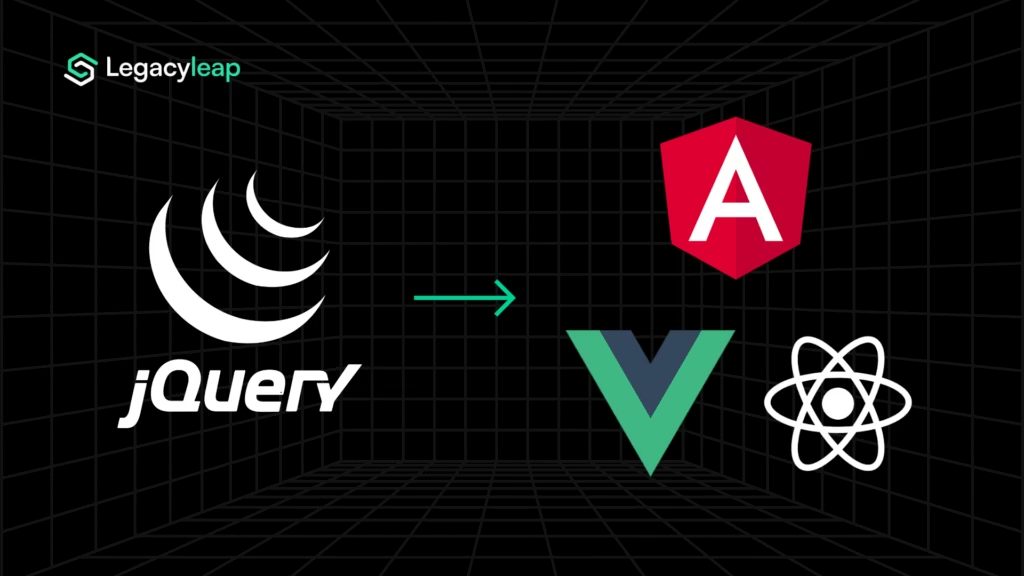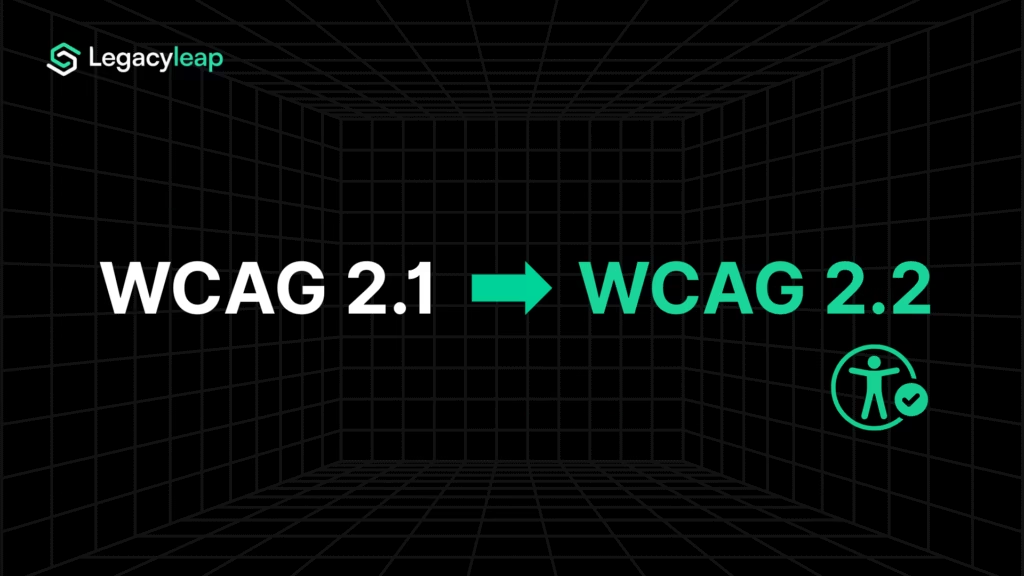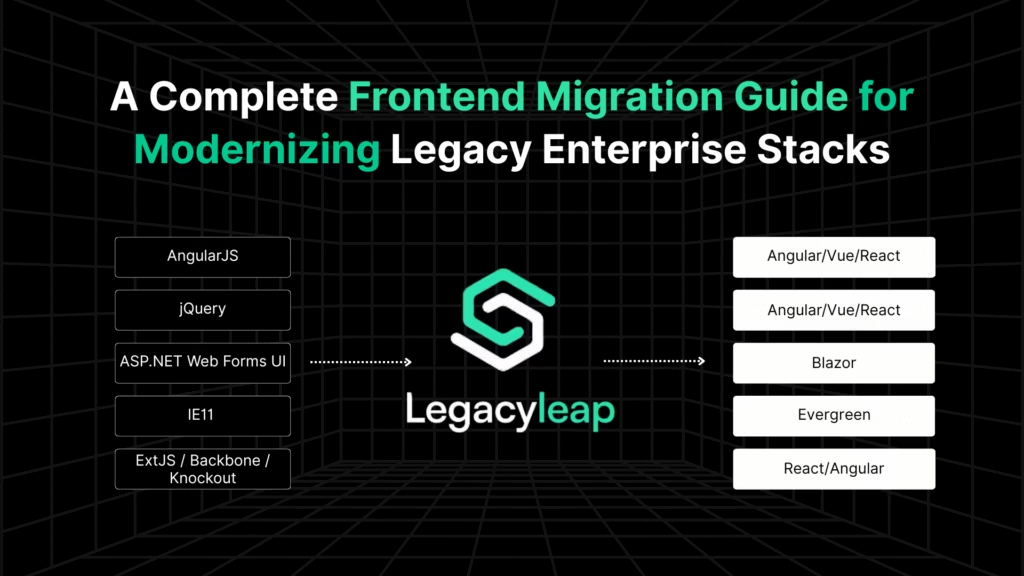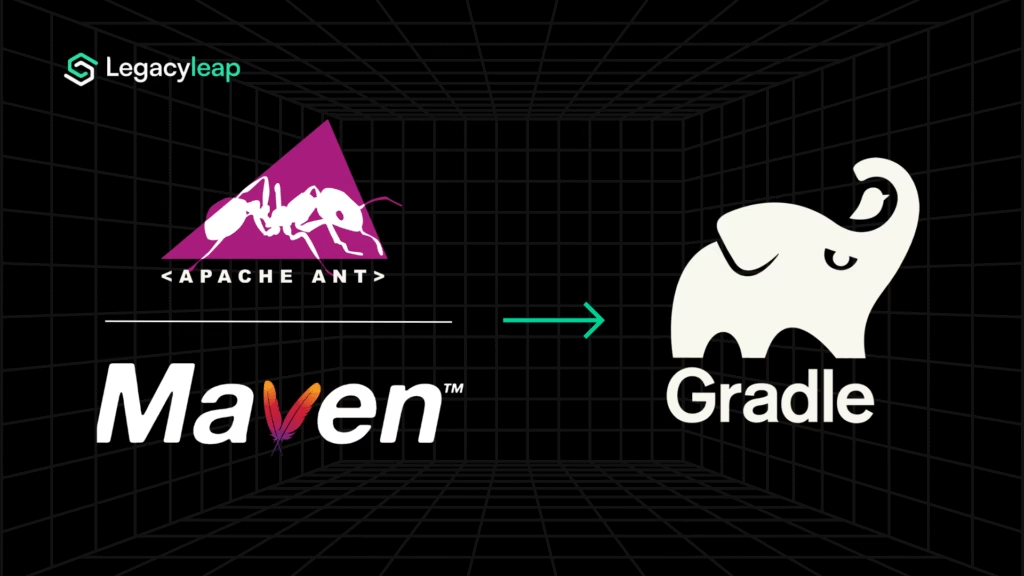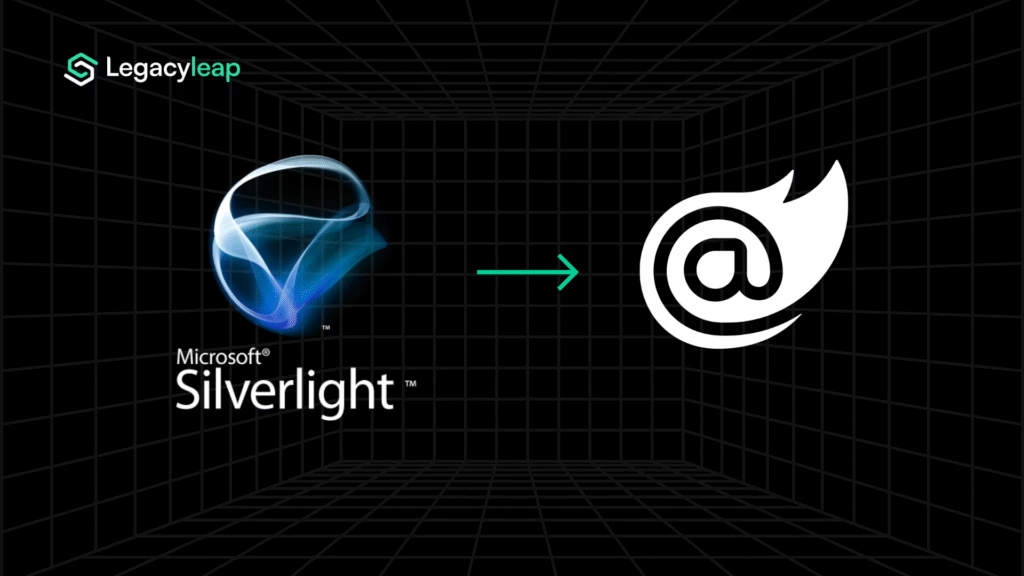The comprehension phase is the cornerstone of any successful application modernization process. It’s where the foundation is laid, setting the stage for aligning legacy systems with future-ready business goals.
Traditionally, this step has relied on time-intensive manual efforts, requiring exhaustive documentation and deep dives into codebases—an approach filled with inefficiencies and risks.
With Generative AI now a viable part of the modernization tooling landscape, it changes how we approach the comprehension phase of the process. By automating documentation, generating visual insights, and delivering a 360-degree understanding of legacy systems, Gen AI redefines the possibilities of this crucial step.
Yet, its potential isn’t without skepticism. Questions about accuracy and reliability persist, making it essential to explore how advanced technologies, when combined with Gen AI, can deliver unparalleled results.
This blog dives into the limitations of traditional comprehension, the transformative power of Gen AI, and why it’s the catalyst that modernization has been waiting for.
Prefer to listen?
This episode of The Legacy2Leverage Show explores the topic in podcast form.
The traditional comprehension process
At its core, the traditional comprehension process focuses on gaining a thorough understanding of legacy applications and their alignment with business goals. This step is vital for setting the direction of modernization efforts but is often encumbered by manual, resource-intensive methods.
What it involves:
- Architecture audits: Teams conduct in-depth reviews of existing systems to uncover bottlenecks, weaknesses, and areas requiring improvement. This includes evaluating codebases, workflows, and dependencies.
- Stakeholder engagement: Insights are gathered across departments to ensure that modernization aligns with user experiences and broader business objectives.
- Manual documentation: Teams labor over documenting applications, including system architecture, dependencies, and workflows. This involves creating blueprints and flowcharts—tasks that demand extensive time and expertise.
The output:
Despite the effort invested, the artifacts produced in the traditional process are often limited. Deliverables like system diagrams and flowcharts provide only a fragmented view of the legacy application.
Without a comprehensive understanding, these outputs frequently fall short of capturing the complexities needed to guide successful modernization.
This reliance on manual processes not only slows down the modernization journey but also leaves room for oversights that can ripple across later stages.
Psst! Curious to explore how Gen AI revolutionizes modernization at every step? Here’s an article for you: How Can Gen AI Drive Every Step of Your Modernization Journey?
Challenges of the traditional process
The traditional approach to understanding legacy systems is fraught with challenges that can impede progress and increase the likelihood of delays or missteps. These hurdles stem from the inherent complexity of legacy systems and the limitations of manual processes.
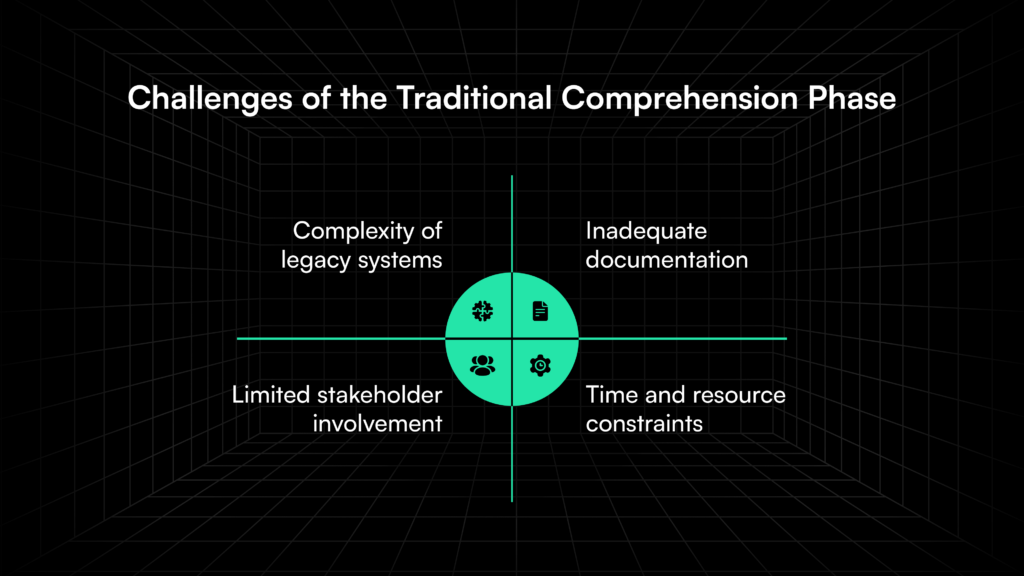
1. Complexity of legacy systems
Legacy applications are often a tangled web of outdated architectures, dependencies, and undocumented changes. Without standardization or a unified framework, comprehending their functionality becomes a daunting task.
Teams must sift through fragmented codebases and workflows, making it challenging to gain a complete picture of how these systems operate and where their vulnerabilities lie.
2. Inadequate documentation
Many legacy systems lack comprehensive or up-to-date documentation. Whether due to years of incremental changes or the absence of proper record-keeping, this void makes understanding the system’s intricacies time-consuming and prone to error.
Teams must spend excessive hours piecing together information, which diverts focus from modernization efforts.
3. Limited stakeholder involvement
Stakeholder input is crucial for aligning technical understanding with business goals. However, traditional processes often overlook cross-departmental insights, leading to misalignment.
This disconnect can result in modernization initiatives that fail to meet business needs or improve user experiences.
4. Time and resource constraints
Manual documentation not only requires significant time and effort but also leaves room for human error. The reliance on individuals to audit, document, and analyze legacy systems slows down the process, creating bottlenecks that ripple across the modernization journey.
These challenges highlight the inefficiencies of the traditional process, underscoring the need for a more dynamic and scalable solution. This is where Gen AI steps in to lay a robust foundation for modernization.
How Gen AI Automates Legacy System Comprehension
The complexity of legacy systems has historically made comprehension a time-consuming and error-prone process.
With Legacyleap, we integrate Gen AI to revolutionize this process, automating critical tasks, delivering deep insights, and enabling teams to visualize, document, and share system details more effectively.
Here’s how it works:
Automated documentation creation
Traditional documentation often involves painstaking manual work, leading to gaps, inconsistencies, or incomplete outputs. Gen AI tackles this challenge by generating robust documentation at scale, with a focus on three distinct types.
1. Business Logic Documentation with Gen AI
With the help of Gen AI, we can extract functional insights directly from legacy code, presenting them in non-technical language. This allows business stakeholders to understand what the system does without needing technical expertise. Outputs include:
- Clear dependency mapping: Understand how key processes are interlinked and how they impact business operations.
- Workflow visualization: Automatically map workflows to high-level business objectives, ensuring alignment between modernization goals and operational priorities.
Actionable insights: Identify redundancies, inefficiencies, and areas for improvement, enabling quicker decision-making by non-technical stakeholders.
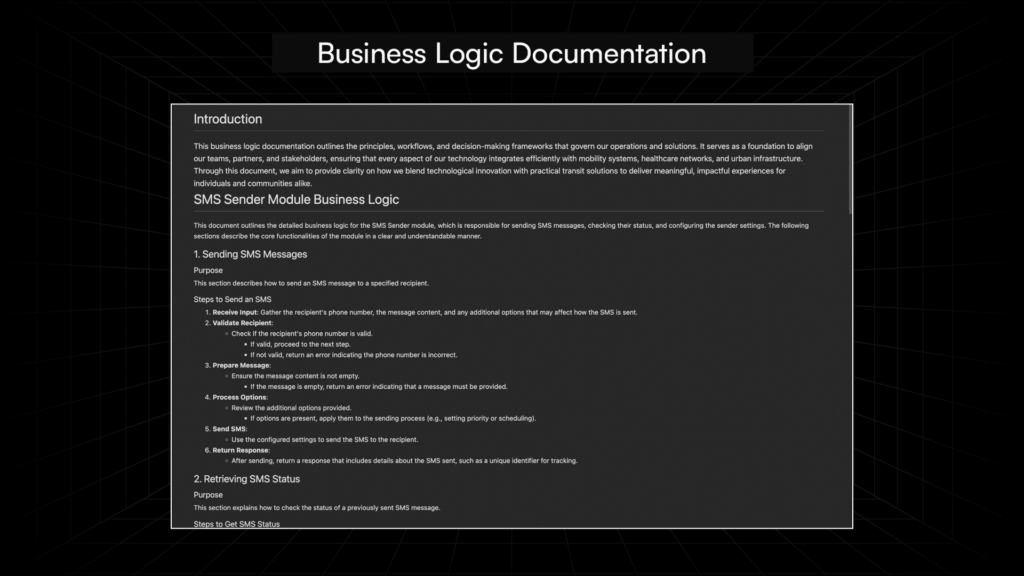
2. API Documentation for Legacy Systems
APIs are critical touchpoints for integration and scalability. Legacyleap employs Gen AI to deliver comprehensive API documentation that empowers developers to optimize and expand system capabilities. A few key outputs include:
- REST endpoint details: Clear descriptions of endpoints, their roles, and associated operations.
- Input/output specifications: Accurate data formats, expected responses, and error-handling guidelines.
- OpenAPI/Swagger specifications: Machine-readable artifacts that accelerate API integration and testing.
- Version history tracking: Automatically document API version updates, ensuring seamless compatibility during modernization.

3. Technical Documentation from Legacy Code
For developers and architects, deep technical insights are indispensable. With Gen AI, we can deliver:
- Code-level analysis: In-depth descriptions of functions, methods, and their interdependencies.
- Error pathway identification: Pinpoint potential failure points for easier debugging.
- Dependency mapping: Visualize interactions between services, databases, and external systems, ensuring nothing is overlooked.
- Performance annotations: Highlight bottlenecks, memory usage, and execution times for targeted optimization.

These documentation outputs cater to every level of a modernization team, from business stakeholders to developers, ensuring seamless communication and alignment.
Mind map generation for quicker comprehension
Gen AI doesn’t stop at linear documentation; it creates mind maps—dynamic, visual representations of the codebase.
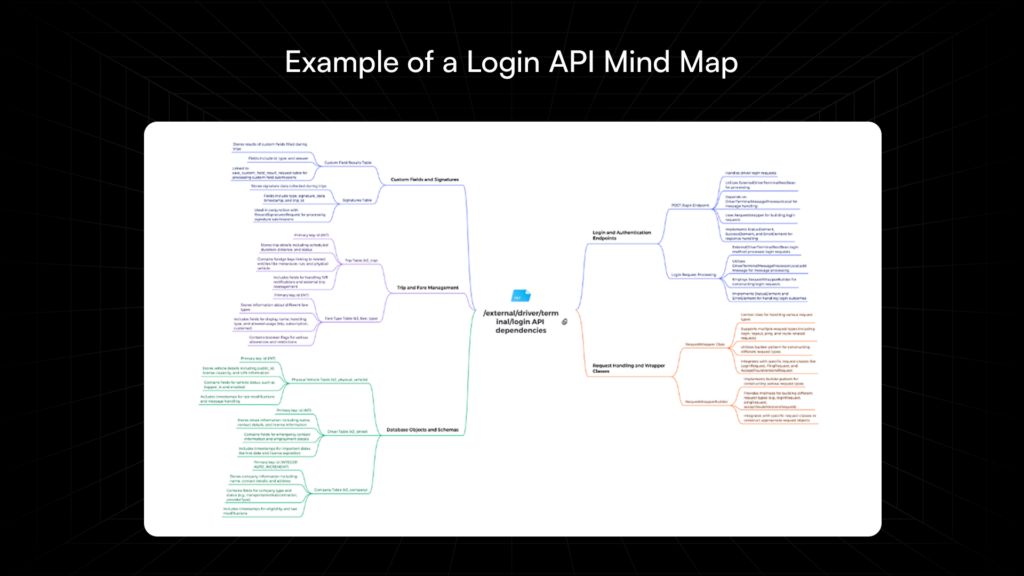
- Developer-friendly views: Simplified representations of the codebase structure, reducing onboarding time and aiding debugging efforts.
- Cross-team collaboration: Stakeholders can use mind maps to align on workflows, dependencies, and modernization goals.
- Accelerating onboarding: For new team members, mind maps provide an intuitive entry point, shortening the learning curve for legacy systems.
For example, a team working on a 10-year-old monolithic application can instantly identify high-risk modules through the generated map, focusing their efforts where it matters most — book a call if you’d like us to show you what this looks like in your own codebase.
3. Centralized repository for artifacts
A major pain point in traditional modernization processes is the siloed nature of documentation and artifacts. With Legacyleap’s Gen AI integration, this issue is resolved through the use of advanced command-line interface (CLI) tools that centralize all project documentation.
These tools ensure that key resources, such as API documentation, technical manuals, and business logic insights, are stored in one unified location, easily accessible by all stakeholders. This centralization simplifies the process of keeping all team members aligned, ensuring that everyone is working from the same, up-to-date set of documents.
Furthermore, Legacyleap includes built-in version control, allowing for real-time tracking of documentation updates and revisions, ensuring that any changes to the system are instantly reflected across all teams.
These centralized repositories reduce the risks of miscommunication and redundant efforts, eliminating the inefficiencies of fragmented, ad hoc documentation. In turn, this enhances workflow efficiency, ensures consistency, and accelerates modernization efforts.
Traditional vs Gen AI-Based Legacy System Comprehension
| Feature | Traditional Approach | Gen AI with Legacyleap |
| Documentation Output | Manually written, outdated or missing | Auto-generated multi-layered documentation (business logic, APIs, workflows, UI mappings) |
| System Mapping | Static call graphs with limited visibility | Dynamic code graphs built using Neo4j and AST/MLIR traversal |
| Business Logic Inference | Relies on tribal knowledge or SME interviews | Inferred from control/data flow and translated to plain English summaries |
| Time to Comprehension | 4–12 weeks on average | <72 hours for initial system overview with deep-linking across modules |
| Stakeholder Alignment | Engineers and business teams operate with different mental models | Shared system map + natural language outputs sync tech and non-tech teams |
| Error Risk | High—due to misinterpretation or undocumented dependencies | Reduced via compiler-backed graph validation and human-AI collaboration |
| Tech Stack Compatibility | Tooling is often stack-specific and brittle | Language-agnostic comprehension layer (supports VB6, EJB, Classic ASP, ColdFusion, etc.) |
| Knowledge Retention | Walkthroughs are not reusable or transferable | Outputs are versioned, navigable, and can be reused across audits, planning, and dev |
Addressing skepticism around Gen AI in modernization
While Gen AI has already shown its value in the modernization process, there are a lot of concerns around its use. One major concern is the fear of AI hallucinations—when an AI system generates outputs that may seem plausible but are factually incorrect.
At Legacyleap, we address this risk by combining Gen AI with compiler technologies and program-specific tools, creating a robust, hybrid approach that minimizes errors and maximizes accuracy.
With the integration of these specialized tools into the Gen AI framework, we can ensure deeper insights into legacy systems, ensuring that the AI doesn’t just produce outputs based on patterns, but also aligns them with real-world, technical data. This ensemble approach leverages multiple technologies in tandem, creating a safety net that guards against the common pitfalls of relying solely on AI.
Pro Tip: Always pair Gen AI with compiler tools and human-in-the-loop workflows to ensure outputs are trustworthy, audit-compliant, and technically accurate.
Moreover, Legacyleap has been built with an essential principle at its core: human-in-the-loop. While Gen AI powers the automation of key processes, developers remain a critical part of the equation, providing expertise and oversight.
This combination of AI-driven efficiency with human judgment ensures that each output—whether it’s documentation or technical insights—is reviewed, refined, and validated by experienced professionals.
The result is a modernized approach that leverages the best of both AI and human expertise, creating a process that is faster, more accurate, and more aligned with business goals than traditional methods.
Comprehension drives modernization success – Legacyleap makes it smarter and faster
We have already seen the real-world impact of Gen AI being integrated into the modernization process, starting with comprehension – the basis of any modernization project.
With automated documentation creation, Legacyleap empowers organizations to gain a 360-degree view of their legacy systems, capturing insights from technical, business, and API perspectives.
This shift in how we approach legacy systems drastically reduces errors, speeds up documentation, and aligns all stakeholders—technical and non-technical—towards a unified modernization goal.
With Gen AI’s ability to automate and streamline documentation, developer productivity soars. The learning curve associated with understanding legacy codebases shrinks, enabling teams to move forward faster.
More importantly, Legacyleap’s hybrid approach, which integrates Gen AI with human expertise, ensures that the insights provided are both accurate and actionable, bringing real value to the modernization process.
As Gen AI takes center stage in the comprehension phase, it becomes clear that modernization is no longer a long, cumbersome process, but a fast and efficient journey. Whether it’s through automated documentation, reduced errors, or enhanced communication between teams, Legacyleap ensures that the comprehension phase is truly worth its weight in gold.
Intrigued about how this looks in reality? Check out our website to discover how we leverage Gen AI to power every step of the modernization journey!
FAQs
Yes, but only when combined with the right comprehension infrastructure. Legacyleap’s Gen AI platform supports older and niche languages like VB6, EJB2, Classic ASP, and ColdFusion. Instead of relying on pattern-matching, it builds internal representations (like AST and MLIR) to understand the structure, logic, and dependencies, even in undocumented or unconventional codebases.
Gen AI in Legacyleap runs entirely within your environment, ensuring that no source code or data leaves your infrastructure. It also applies model context restriction protocols (MCP), meaning only the necessary fragments are exposed to Gen AI agents. This architecture enables secure, enterprise-grade comprehension without risking data privacy or compliance boundaries.
No. Legacyleap is designed to work with real-world legacy systems as they are: messy, undocumented, and tightly coupled. The platform can parse and comprehend even poorly structured codebases by generating auto-linked documentation, code graphs, and plain-English summaries without needing pre-cleaning or manual annotations.
Extremely scalable. Legacyleap breaks down large monoliths into modules using internal code graphs and processes them in parallel. It can handle tens of thousands of files while preserving architectural context. Outputs include dependency maps, UI-to-logic flows, and inferred business logic, making even enterprise-scale comprehension fast and manageable.
Yes. All outputs – technical summaries, Swagger specs, business logic explanations, and API mappings – can be exported in developer-friendly formats. These can be integrated into internal documentation portals, wikis, or knowledge bases to ensure ongoing access, collaboration, and reuse across teams.


